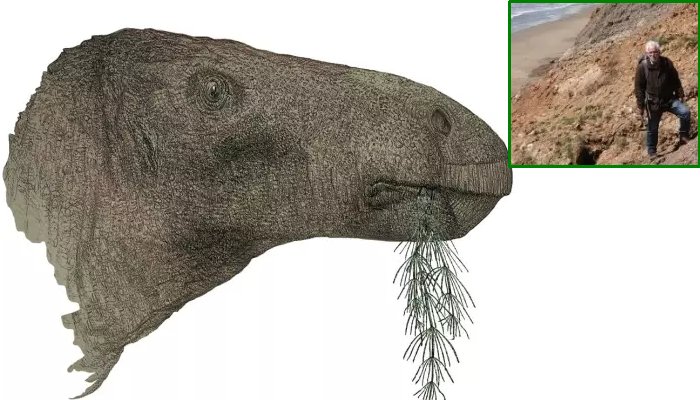Eddie Gonzales Jr. – MessageToEagle.com – The most complete dinosaur discovered in this country in the last 100 years, with a pubic hip bone the size of a “dinner plate,” has been described in a new paper published in the Journal of Systematic Palaeontology.
Comptonatus chasei gen. et sp. nov. (IWCMS 2014.80). Life restoration. Original artwork by John Sibbick. Credit: Journal of Systematic Palaeontology (2024). DOI: 10.1080/14772019.2024.2346573
The 125-million-year-old specimen was discovered in 2013 on the Isle of Wight by fossil collector Nick Chase, before he tragically died of cancer. Jeremy Lockwood, a retired GP and PhD student, helped excavate and analyze 149 bones of a dinosaur skeleton. He identified it as a new genus and species, naming it Comptonatus chasei in tribute to Nick.
Jeremy said: “Nick had a phenomenal nose for finding dinosaur bones — he really was a modern-day Mary Anning. He collected fossils daily in all weathers and donated them to museums. I was hoping we’d spend our dotage collecting together as we were of similar ages, but sadly that wasn’t to be the case.
Jeremy discovered a new dinosaur genus, the first named after him. Initially thought to be a Mantellisaurus, his research revealed greater dinosaur diversity.
This is Jeremy’s second new genus description.
“I’ve been able to show this dinosaur is different because of certain unique features in its skull, teeth and other parts of its body. For example its lower jaw has a straight bottom edge, whereas most iguanodontians have a jaw that curves downwards. It also has a very large pubic hip bone, which is much bigger than other similar dinosaurs. It’s like a dinner plate,” he said.
Jeremy is uncertain about the large pubic hip bone at the abdomen’s base. He speculates it could have been for muscle attachments, stomach support, or breathing, but admits these theories are unconfirmed.
“This animal would have been around a ton, about as big as a large male American bison. And evidence from fossil footprints found nearby shows it was likely to be a herding animal, so possibly large herds of these heavy dinosaurs may have been thundering around if spooked by predators on the floodplains over 120 million years ago,” the researcher said in a press release.
The dinosaur was named Comptonatus after Compton Bay where it was found and ‘tonatus’ is a latin word meaning ‘thunderous’.
“Comptonatus is a fantastic dinosaur specimen: one of the most complete to be found in the UK in a century,” Dr Susannah Maidment, Senior Researcher and palaeontologist at the Natural History Museum and senior author of the paper, commented:
“Its recognition as a new species is due to incredibly detailed work by NHM Scientific Associate Dr. Jeremy Lockwood, whose research continues to reveal that the diversity of dinosaurs in southern England in the Early Cretaceous was much greater than previously realized.
“The specimen, which is younger than Brighstoneus but older than Mantellisaurus (two iguandontian dinosaurs closely related to Comptonatus) demonstrate fast rates of evolution in iguandontian dinosaurs during this time period, and could help us understand how ecosystems recovered after a putative extinction event at the end of the Jurassic Period.”
Eight new dinosaur species have been named on the Isle of Wight in the past five years, compared to only four in the entire 1900s.
This significant discovery contributes to better understanding of Early Cretaceous dinosaur diversity in England, supporting recent research that highlights Wessex as one of the world’s most diverse ancient ecosystems.
Paper:
Jeremy A. F. Lockwood, David M. Martill, Susannah C. R. Maidment. Comptonatus chasei , a new iguanodontian dinosaur from the Lower Cretaceous Wessex Formation of the Isle of Wight, southern England. Journal of Systematic Palaeontology, 2024; 22 (1) DOI: 10.1080/14772019.2024.2346573
Written by Eddie Gonzales Jr. – MessageToEagle.com Staff Writer








